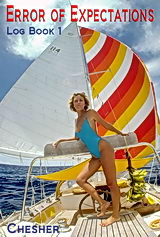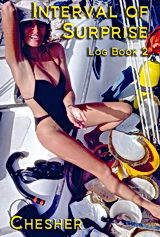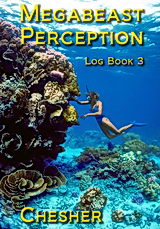Tour of the Research Vessel Moira
Freddy and I have been aboard the Moira every day and every night since 1976, when this log began.
So this is a time trip, an adventure into perceptions and memory and communications. You might enjoy it more as an ebook and you can order those using the links in the side bar.
Moira is number 14 in a production of 356 Peterson 44s. Considered one of the best cruising yachts in the world, she was designed by Doug Peterson - well known for his championship designs in one ton racing sloops.
She was designed as a fast, center cockpit, aft cabin cruising yacht, with excellent performance in all conditions of blue water cruising. The notched keel and waterline double ended design handle well headed into the wind or with a following sea.
Moira is built out of fiberglass trimmed in teak. The hull is hand molded fiberglass up to 2.5 cm thick at the turn of the bilge. Her decks are fiberglass with internal plywood for rigidity. She is painted with linear polyurethane.
At sea, Moira's main propulsion is from 83 mē of sail (894 ttē). Her sails were built by North Sails of San Diego. There are three sails. A 110% roller furling headsail on Harken Roller Furling gear, a hanked on - very rugged staysail just aft of the headsail, and a slab-reefed mainsail. From a broad reach to hard on the wind all sails are used together. With a following wind we find the boat handles best with only the 110% lapper. We are too lazy for drifters or spinnakers and seldom even use a spinnaker pole. Under prime conditions Moira sails comfortably at 7 to 9 knots. Usual average passages maintain 6 knots.
The mast is made by LaFiell, in California and is stepped on the 5 ton iron keel. The top of the mast is about 19 meters from the water. All fittings and standing rigging are stainless steel except the turnbuckles and chainplates which I had cast out of aluminum nickel bronze.
I designed and built the fiberglass dodger that protects the roomy center cockpit. The cockpit cover can be completely zipped up at sea, making her very comfortable in all weather conditions. She has pedestal steering with a large stainless wheel that is almost never used. The boat is normally steered by the Autohelm 6000 autopilot with a linear drive suitable for a yacht twice the length of the Moira.
Navigation is by Garmin GPS (2) with sextant back up. Moira has SSB and VHF radio, and a Satellite Receiver for obtaining weather images from orbiting satellites.
The 60 hp fresh water cooled, 4-cylinder Cummins Diesel provides auxiliary power, driving the Moira at 5 knots under most conditions. In an emergency she can make 7 under power. We run the engine once a day, every day, for about an hour to provide electricity (12 volts or 110 VAC), heat the water for the showers, pull down the freezer to -18š C., and make fresh water for the day from our Pur desalinater. There are three big 210 amp hour batteries charged with a Balmar 150 amp alternator. All our energy needs are met for 2.4 liters of diesel fuel a day. Moira carries 440 liters of diesel in two steel fuel tanks.
Our ground tackle includes 350 feet of 10-mm chain hauled in by a Nilsson Electric Windlass. The main anchor is a 27 KG CQR plow. We use a 10 KG High Tensile Danforth back-up in tandem with the plow, under really horrible conditions.
We use a 4 meter inflatable dingy with a 25 hp Mercury outboard.
Moira's 4 stainless water tanks hold nearly 500 liters of water but this is used only for bathing and washing up. All water is supplied via a pressure water system.
All our drinking and cooking water for the past ten years was provided by watermakers.
We have a splendid watermaker by EchoTec that supplies 80 liters/hour and has run flawlessly for nearly a decade.
Freddy's galley has a highly efficient, large refrigerator/freezer, which I built myself, driven by belt off the engine. There is a three burner LP gas stove with oven and broiler, a microwave oven, food processor, blender, juicer, and pressure cooker. Counter tops are white Formica.
Moira is exceptionally roomy compared to other boats her size, with the interior divided into four sections, a main salon, forward stateroom, companionway aft (and engine room), and a spacious aft cabin. There are two showers and toilets.
The bulkheads are teak and teak veneer and the interior deck is teak and holly. The wood work is beautifully finished by the Chinese builders. Three opening hatches scoop air and light into the interior. There are also three ventilators to provide air in all weather conditions. At sea, all these are normally sealed.
The forward cabin has two Vee berths with hanging lockers and drawers (in practice this is a storage area). The main cabin has a settee on the starboard side that we use as a bunk on the port tack. The dinette table lowers to form a queen-sized bunk on the port side that we use on starboard tacks. In port we sleep in the aft cabin, with its king-sized bed.
Moira's Statistics
Length Overall |
13.4 Meters |
Length Water Line |
11.8 Meters |
Beam |
4.0 Meters |
Draft |
2.0 Meters |
Ballast |
4,536 KG |
Displacement |
12,701 KG |
Sail Area |
83 Metersē |
Fuel |
440 Liters |
Water |
500 Liters+ |
Batteries |
630 amp. hr. |



